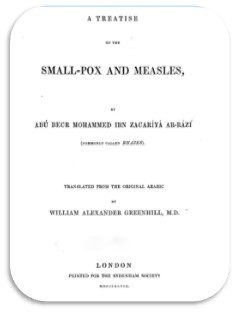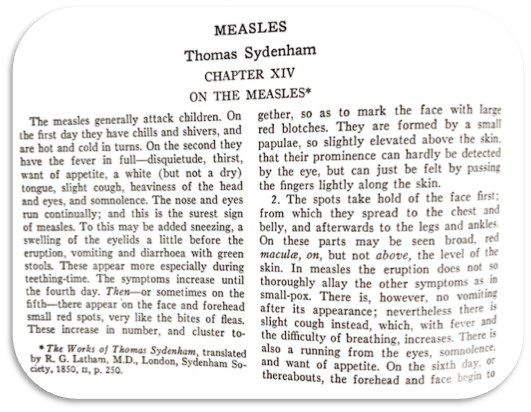JMS Pearce
Hull, England
“Measles is tearing through the UK, spooking health chiefs and parents alike.”
– Daily Mail, 25 Jan 2024
Measles is notoriously infectious. Ninety percent of people exposed to an infected person will contract the disease. In many countries, because of misguided anti-vaccine activists, Measles Mumps Rubella (MMR) vaccination rates have fallen in recent years.1 Consequently, epidemic outbreaks of measles have reemerged. In England, on 8 February 2024, the number of cases confirmed since 1 October 2023 was 465. Measles was declared eliminated in the US in 2000, but 1,274 cases were reported in 31 states in 2019. In 2023, over 42,200 cases were reported across 41 European states.
Clinical features
After an incubation period of about ten days, the patient develops fever, redness, and profuse watering of the eyes, nose, and throat, which lasts up to four days. One to three days before the typical rash, white maculae named Koplik spots appear in the mucous membranes of the mouth. The fever continues and a red, blanching, maculopapular rash spreads from the face and neck to the trunk and limbs. After two to four days, the rash fades and the fever subsides, usually just over a week from the onset. Patients are contagious from five days before to four days after the rash.
The complications in about 1 in 10 patients are: otitis media, pneumonia, and diarrhea. Encephalitis complicates the illness in about 1 per 1,000 cases, and subacute sclerosing panencephalitis is a rare but fatal late complication, typically 4–10 years after primary early childhood measles.*
History of measles

The Oxford English Dictionary’s earliest citation of the word “measles” is before AD 1325, in the Glossary of Walter de Bibbesworth. The word morbilli appeared in c. 1450 as the characteristic maculopapular rash. The synonym rubeola was first recorded in 1583.
Early accounts were often confusing, the rash frequently being mistaken for smallpox or rubella well into the twentieth century:
The measles have a great affinity with the small-pox.2
The measles have been considered by authors to have much resemblance to the small-pox, and I am of the opinion they bear a striking resemblance in many of their phenomena.3
The earliest description was probably given by the Persian physician Rhazes (c. 865–925), author of the twenty-two-volume Book on Medicine Kitab al-Hawi fi al-tibb, which stands as an accurate account and attempts to differentiate measles from smallpox.4
The small-pox and measles are preceded by an acute fever, with violent pain and heaviness of the head, redness of the face, cough, dryness of the tongue and saliva; the veins of the face are swollen and inflated; the saliva is thick and viscid; and there comes on an itching of the nose, sneezing, redness of the eyes, with itching and a flow of tears, and puffiness of the face. The breathing is impeded, and there is disturbance of the mind, vomiting, loss of appetite, and a feeling of heaviness in the whole body. When you see these symptoms, the small-pox or the measles will certainly appear … The difference between the two I have found to be, that the measles are red, and appear only on the surface of the skin, without rising above it, while the small-pox- consists of round eminences.4
Thomas Sydenham, the supreme practicing physician, was considered by the College of Physicians inadmissible as a Fellow; they only granted him a Licentiate in 1663. The Royal Society also ignored him. His clinical prowess was greatly admired, more abroad than at home. His meticulous, minute observations on measles were based on the outbreaks of the years 1661 to 1676, recorded in his treatise on epidemic diseases.5

Koplik’s spots
Koplik’s spots are an important warning sign of the impending measles rash. Henry Koplik (1858–1927) was a New York pediatrician, who in 1896 reported fifty-two consecutive cases examined at his clinic. The diagnosis of measles was made in thirty-two, 24 to 72 hours before any sign of an eruption appeared:
It appears on the mucous membranes of the inside of the cheeks and on the lips… The eruption of the exanthemata of measles on the buccal mucous membrane, its spread and decline, forms a sort of cycle which can be verified by any one who will study it. The height of the eruption is reached just as the skin eruption has appeared and is spreading. When the skin eruption of measles is at its efflorescence, the eruption on the buccal mucous membrane has begun its decline… small irregular spots, of a bright red color. In the center of each spot, there is noted, a minute bluish white speck, absolutely pathognomonic of beginning measles, and when seen can be relied upon as a forerunner of the skin eruption.6
Francis Home in 1757 transmitted measles from infected patients to healthy individuals through blood, demonstrating that the disease was caused by an infectious agent. The epidemiology of measles was established by Peter Panum, a Danish physician in his seminal “Observations Made During the Epidemic of Measles on the Faroe Islands in 1846.” He showed the disease was transmitted from person to person and from village to village by contagion.7
Ludvig Hektoen carried out experimental human transmission of measles in 1905. The virus was first propagated in tissue culture from patients with measles in 1954 during an outbreak in Boston, by virologist John Franklin Enders (“Father of Modern Vaccines”) and pediatrician Thomas Peebles, a former World War II bomber pilot. The widespread use of live measles vaccine, started by Enders in 1960,8 was contained in the effective measles, mumps and rubella (MMR) vaccine.
Note
* US Centers for Disease Control and Prevention, Complications of Measles, 5 Nov 2020, https://www.cdc.gov/measles/symptoms/complications.html.
References
- Hübschen JM, Gouandjika-Vasilache I, Dina J. Measles. The Lancet, 2022;399 (10325):678-90.
- Mead Richard. Of the Measles, the Medical Works of Richard Mead, M.D. Lond, 1762.
- Ferguson T. Of the Epidemic Measles of 1808. Med and Phys Journ, Lond 1809;359.
- Abu Becr Mohammed ibn Zacariya Ar-Razi (commonly called RHAZES) Treatise on Small-pox and Measles for the Sydenham Society, translation by Greenhill, WA. London, 1848, p. 127. Reprinted by Emerson Crosby Kelly MD Medical Classics 1939;4, No. 1. Baltimore, Williams and Wilkins. 1939.
- Sydenham T. Observationes medicae circa morborum acutorum historiam et curationem. Londoni: Typis A.C. Impensis Gualteri Kettilby? 1676. reprinted in Medical Classics 1939;4:313-9.
- Koplik H. The diagnosis of the invasion of measles from a study of the exanthema as it appears on the buccal mucous membrane. Arch Pediatr 1896; 13: 918-22.
- Dycus K. Peter Panum and the “geography of disease”. Hektoen Int. Summer 2021.
- Enders JF. Development of attenuated measles virus vaccines. Am J Diseases of Children 1962;103:335.
JMS PEARCE is a retired neurologist and author with a particular interest in the history of medicine and science.

Leave a Reply